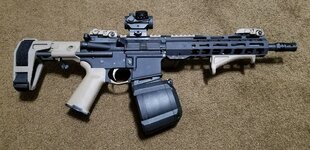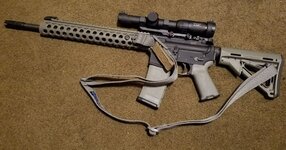- Messages
- 18,744
- Reactions
- 45,474
What self control?? I've got quite a bit as it sits right now...but I feel that could go out the window quick
Yep
Follow along with the video below to see how to install our site as a web app on your home screen.
Note: This feature may not be available in some browsers.
What self control?? I've got quite a bit as it sits right now...but I feel that could go out the window quick
That is some good info to have there my friend. Really appreciate all the advice and everything. Looks like tomorrow I start with my Barrel and whatever else I can acquire. In my hunting.I also have a strong preference to an A5 buffer system and mid-length gas system on 16" barrel with a good port size of 0.076. That combination make an amazing smooth shooting machine.
Be extra careful installing trigger guard pin, those aluminum "ears" on the lower can snap, use a block to support them.
Well if she can have "furniture" in the kitchen so can you.
Good reminder, but you don't need the hockey puck support things if you just install the grip before installing the trigger guard roll pin. Typically it is the bottom ear that snaps off from rolling the the lower over it, with the grip in place it prevents the roll over.




That was my issue, the roll pin failed to start and collapsed lol. I had a hell of a time with hammering roll pins until I got a good set of roll pin holders and bought a smaller hammer. Haven't had a problem since.I tend to put the slightest crimp on the leading end of the rollpin. Just enough to get it sitting in the hole before crimping with pliers. I try to avoid using any sort of hammer since I added some "character" to my first lower too. Sharpie or paint pen can help conceal that character though.
replaced with a little Ariska stop to help keep my hand behind the muzzle.
And this was my first AR. Anderson lower with BCM LPK and AR15Performance .223 Wylde 16" barrel with a ceracoated Troy Alpha rail. Foliage green furniture. Primary Arms 1-6 scope.
View attachment 688244
Some of the newer lowers have the trigger guard built into the frame, which is nice because that's sort of a stupid part to have to put in there.